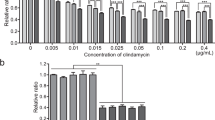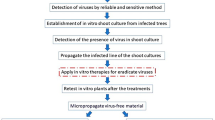Abstract
Odontoglossum Ringspot Virus has been eradicated from Cymbidium Sw. through chemotherapy based on incorporation of ribavirin (VIRAZOLE®) into the in vitro culture medium of protocorms. Applications of the virustatic agent for several consecutive subcultures freed protocorms of the virus. Acclimated plantlets regenerated from those protocorms are healthy as determinated by enzyme-linked immunosorbent assay (ELISA). No resurgence of virus occurred over a period of 5 years. Besides, trueness to type was total at flowering level and the batch grown was perfectly homogeneous.
To secure fast and effective eradication of the virus during the consecutive subcultures of protocorms with ribavirin, three factors proved to be of prime importance: accurate isolation of new growths from initial tissues, VIRAZOLE® concentration and frequency of transplanting in new media.
Similar content being viewed by others
References
Clark MF & Adams AN (1977) Characteristics of the microplate method of enzyme-linked immunosorbent assay for the detection of plant viruses. J. gen. Virol. 34: 475–483
Dawson WO (1984) Effects of animal antiviral chemicals on plant viruses. Phytopathology 74: 211–213
Fraselle J (1968) Aspect pratique de la culture de méristèmes d'orchidées. Colloque: Fac. Sciences Agronomiques de Gembloux. Les nouveautés récentes dans la multiplication des plantes (pp 52–70). Multicopie, Charleroi
Knudson L (1946) Solution C—For orchid seedlings in culture. Amer. Orchid Soc. Bull. 15: 214–217
Kummert J & Toussaint A (1984) Utilisation du VIRAZOLE® pour l'assainissement des plantes par culture in vitro. Parastitica 40: 121–137
Lawson R & Ali S (1975) Orchid viruses and their detection by bioassay, serology and electron microscopy. In: Handbook on Orchid Pests and Diseases (pp 62–103). American Orchid Society, Cambridge
Lerch B (1976) Entwicklung chemotherapeutischer Verfahren gegen Pflanzenpathogene Viren. Biol. Bundesanst. Land-u. Forstwirsch. Berlin (West) u. Braunschweig, jahresber. 1975, 64
Lozoya-Saldana H, Dawson W & Murashige T (1984) Effects of ribavirin and adenine arabinoside on tobacco mosaic virus in Nicotiana tabacum L. var. Xanthi tissue culture. Plant Cell Tiss. Org. Cult. 3: 41–48
Morel G (1963) La culture in vitro du méristème apical de certaines orchidées. C.R. Acad. Sci. Paris 256: 4955–4957
Post PD (1949) Orchids. In: Florist Crop Production and Marketing (pp 663–717). Orange Judd Publishing Company, New York
Sidwell RW, Huffman JH, Khare GP, Allen LB, Witkowski JT & Robins RK (1972) Broad spectrum antiviral activity of Virazole 1-b-D-ribofuranosyl-1,2,4-triazole-3-carboxamide. Science 177: 705–706
Shepard JF (1977) Regeneration of plants from protoplasts of potato virus X-infected tobacco leaves. II. Influence of Virazole on the frequency of infection. Virology 78: 261–266
Sheehan TJ, Wisler GC & Zettler FW (1981) Orchid viruses-Their distribution and new detection techniques. Proc. of the 10th World Orchid Conf. (pp 279–285). Durban
Toussaint A (1985) Contribution à la caractérisation des viroses de Cymbidium cvs cultivés en Belgique et possibilité de leur éradication par la culture in vitro (388 p.). Thèse de doctorat, Faculté des Sciences Agronomiques de Gembloux (Belgium)
Toussaint A & Albouy J (1982) Application de la méthode immunoenzymatique à la détection de deux virus dans des plantes de Cymbidium d'âges différents. Agronomie 2: 901–903
Toussaint A, Dekegel D & VanHeule G (1984) Distribution of Odontoglossum Ringspot Virus in apical meristems of infected Cymbidium cultivars. Physiol. Plant Pathol. 25: 297–305
Toussaint A & Kummert J (1986) Essais d'éradication du virus des anneaux nécrotiques de l'odontoglossum chez Cymbidium Sw. par culture in vitro en présence de Virazole. Revue de l'Agriculture 2: 407–414
Vanseveren N & Freson R (1969) La multiplication des orchidées par la méthode de culture in vitro des méristèmes de tige. Bull. Nat. Belges 50: 444–460
Vidalie H (1971) Le Cymbidium. P.H.M. 116: 17–24
Witkowski JT, Robins RK, Sidwell RW & Simon LM (1972) The design, synthesis and broad spectrum antiviral activity of 1-b-D-ribofuranosyl-1,2,4,-triazole-3-carboxamide and related nucleosides. J. Med. Chem. 15: 1150–1154
Yeun CK, Kamemoto H & Ishii M (1979) Transmission of Cymbidium mosaic virus through seed propagation in Dendrobium. Amer. Orchid Soc. Bull. 48: 1245–1247
Author information
Authors and Affiliations
Rights and permissions
About this article
Cite this article
Toussaint, A., Kummert, J., Maroquin, C. et al. Use of VIRAZOLE® to eradicate odontoglossum ringspot virus from in vitro cultures of Cymbidium Sw.. Plant Cell Tiss Organ Cult 32, 303–309 (1993). https://doi.org/10.1007/BF00042293
Received:
Accepted:
Issue Date:
DOI: https://doi.org/10.1007/BF00042293




